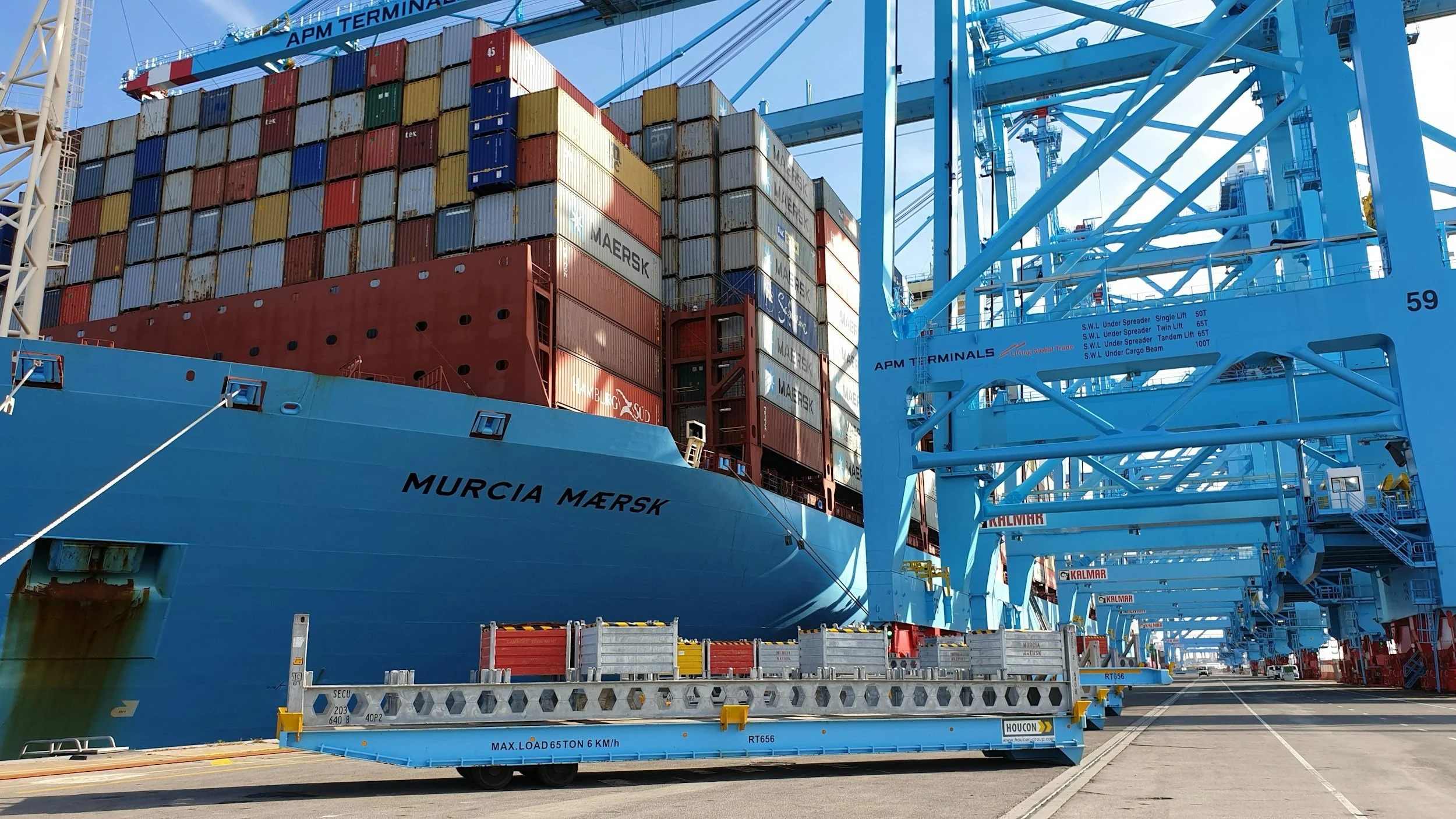U.S. Tariff and Foreign Policy Shifts
: Impact on Global Trade and Container Markets (2025–2026)
* Executive Summary (At a Glance)
| Topic | Key Point | Actionable Insight |
|---|---|---|
| Tariff Actions | Sec.232: Autos 25% (Apr 3, 2025); Steel/Aluminum 50% (Jun 4, 2025); Wood/Furniture 10–25% (Oct 14, 2025). | Check mixed-origin content and HS codes; adjust procurement and timing. |
| Market Signals | Drewry WCI $1,669/FEU (Oct 2, 2025), 16 weeks of declines. U.S. Ports +1.7% YoY (imports +4.3%, exports –4.2%). | Use short-term buyer leverage; plan shipments considering post front-loading softening. |
| Cost Impact | Steel/aluminum tariffs (+50%) → estimated +15–18% new-build cost; Wood/furniture tariffs → estimated +8–10% for floors/interiors (varies by spec/coverage). | Implement index-linked surcharges; compare refurbishment vs. new build ROI. |
| Strategy | Leasing activity increased in 2025; used prices softened with regional variation. | Stage CAPEX quarterly; monitor lane spreads and dwell times. |
Data: Drewry (Oct 2, 2025), BIMCO (H1 2025), IMF/WTO (2025 updates).
1) Policy & Legal Timeline (2025)
Short-term enforcement delays often lead to front-loading, rate spikes, and then demand softening.
| Effective Date | Measure | Key Details |
|---|---|---|
| Apr 3, 2025 | Automobiles & Parts (Sec. 232) | 25% on non-U.S. content under USMCA; verify mixed-origin components. |
| Jun 4, 2025 | Steel & Aluminum (Sec. 232) | Raised from 25% → 50%; estimated +15–18% new-box/chassis cost (varies by spec). |
| Oct 14, 2025 | Wood & Furniture (Sec. 232) | 10–25% tariffs; phased coverage; wood interiors estimated +8–10% (coverage/staging vary). |
Interpretation tip: Expect ~2–3 months between announcement and cost realization; include price re-opener clauses.
2) Macro & Trade Snapshot
IMF/WTO guide mid-term planning (6–12 months); Drewry WCI provides weekly tactical signals.
| Indicator | Latest | How to Use It |
|---|---|---|
| IMF Global GDP | 2025: 3.0%; 2026: 3.1% | Use for annual procurement and CAPEX planning. |
| WTO Trade Outlook | Recovery in 2025; deceleration risk in 2026 | Quarterly demand planning baseline. |
| Drewry WCI (Composite) | $1,669/FEU (Oct 2, 2025); 16 weeks of declines | Short-term freight rate gauge; reflects buyer leverage. |
| Shanghai → Los Angeles | $2,196/FEU | Benchmark for West Coast contracts. |
| Shanghai → New York | $3,200/FEU | East Coast benchmark; compare to LA spread for routing. |
| U.S. Ports (H1 2025) | Top-9: +1.7% YoY (imports +4.3%, exports –4.2%) | Front-loading evident; expect moderation in Q4. |
Interpretation tip: Align short-term shipments with WCI trends; set CAPEX using IMF/WTO baselines.
3) Impact on Container Trading & Logistics
Leasing activity increased in 2025 amid policy uncertainty; used container prices softened modestly with notable regional variation.
| Driver | Observation | Operational Implication |
|---|---|---|
| Demand & Pricing | Imports softened after front-loading; rates near breakeven. | Shorter contracts; frequent rebids to exploit leverage. |
| Supply & Networks | Blank sailings mitigate oversupply from new builds. | Secure alternate routings; monitor reliability swings. |
| Leasing & Resale | Leasing activity up; used prices softer (regional variation). | Prioritize cash flow with short-term leases; select mid-age units. |
| Material Costs | Steel/aluminum +50%; wood +10–25% on covered items. | Adopt index-linked surcharges; compare refurb vs. new ROI. |
| Policy Risk | China-linked cargo surcharges; extended Sec.301 actions. | Stress-test margins; diversify suppliers and routes. |
Interpretation tip: Prioritize lease renewals until tariff scope stabilizes; stagger new purchases quarterly.
4) 2025–2026 Scenario Outlook
Track the following “trigger signals” to adjust procurement and pricing strategies.
| Scenario | Policy Path | Market Effect | Trigger Signals | Recommended Action |
|---|---|---|---|---|
| Easing | Partial rollback / exemptions | Rates stabilize; imports rebound | Steel ↓ >10%; exemption expansion | Resume new purchases; extend contracts. |
| Status Quo | 25–50% maintained | Flat imports; higher leasing share | WCI $1,600–1,800; no new tariffs | Maintain leasing strategy; defer large CAPEX. |
| Tightening | Scope expansion / retaliation | Freight downturn; margin compression | Steel +15%; WCI < $1,500 | Reduce exposure; negotiate pass-through clauses. |
Interpretation tip: Use WCI or steel index thresholds as internal alert levels to trigger policy or pricing adjustments.
5) Strategic Guidance
Actions are ranked by priority and execution horizon. High = immediate (1–3 months), Medium = within 6 months.
| Priority | Action | Why It Matters | Execution Hint |
|---|---|---|---|
| High | Dual Procurement | Balances flexibility and cost control. | Blend leasing + used purchases; defer CAPEX quarterly. |
| High | Continuous Monitoring | Enables rapid reaction to tariff changes. | Set weekly WCI alerts; follow USTR releases. |
| Medium | Diversify Gateways | Reduces exposure to route-specific tariffs. | Compare LA/LB vs. East Coast cost spreads quarterly. |
| Medium | Flexible Contracts | Buffers against freight volatility. | Use WCI/SCFI index-linked clauses with re-opener terms. |
| Watch | Pass-Through Strategy | Protects margins from cost shocks. | Apply surcharges tied to steel/aluminum indices. |
Sources: Drewry (Oct 2, 2025), IMF (Jul 2025), WTO (Apr 2025), BIMCO (H1 2025). Section 232/301 actions remain subject to court review.
6) Glossary of Key Terms
Quick Reference for Non-Specialists
| Term | Definition | Relevance |
|---|---|---|
| Section 232 | U.S. national security tariff authority. | Impacts raw material and finished goods costs directly. |
| Section 301 | Tariffs addressing unfair trade practices. | Potential expansion affects China-linked cargo. |
| WCI | Drewry World Container Index (weekly). | Used to gauge global spot freight trends. |
| Front-loading | Shipping goods early before new tariffs. | Causes short-term rate surges, then demand dips. |
| Index-linked Clause | Contract ties cost adjustments to an external index. | Automates risk mitigation for volatility. |

